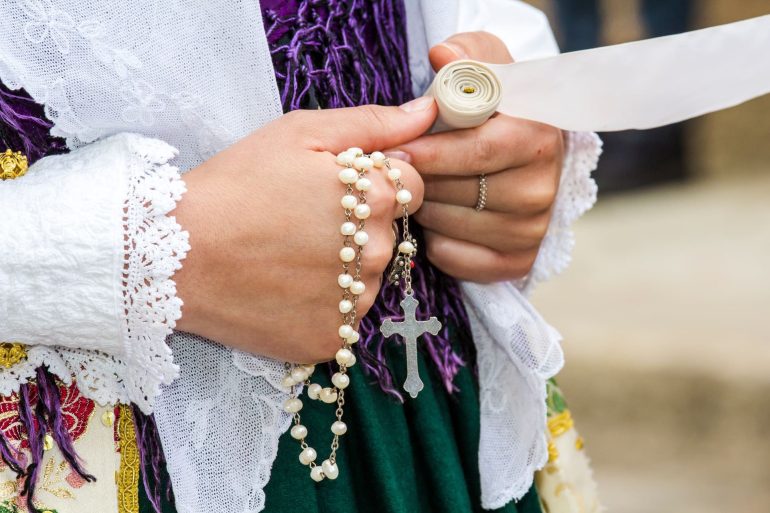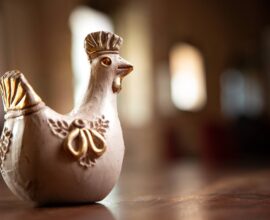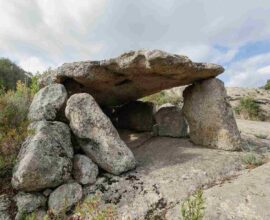Sa chida santa: the rites of Holy Week in Sardinia
Easter in Sardinia: a tradition between faith, charm and mystery
Visiting the island during Holy Week is a unique opportunity to discover 400 years old traditions.
In fact, in Sardinia the rites of Holy Week (in Sardinian, Sa Chida Santa) date back to the 17th century. That was a period of Spanish domination. That’s why they mix ancient mystical-religious customs (in the Campidanese, Logudorese and Barbagia regions) with Iberian traditions.
The result is series of rites, evocative processions and fascinating chants that are a great national and international tourist attraction.
Some rites, organized by the various brotherhoods, don’t change much from one location to another. Some examples are the Palm Sunday procession (sas Prammas) and the setting up of the Sepulchres (sos Sepurcros) inside the churches. But also, the procession of the dead Christ on Good Friday and the s’Incontru procession (the encounter between the Risen Jesus and his Mother Mary) on Easter Sunday morning.
Even the su Nennere, one of the most widespread Easter traditions in Sardinia, is the same every year. It consists on growing wheat, barley and oat seeds in a small earthenware or wicker pot in total darkness.
Women prepare Nennere 40 days before Easter, on the Day of Ashes. They arrange the seeds on cotton soaked in water and then cover them with topsoil. Once ready, they place the pot in a dark and dry place and water it regularly. In the past they usually under place it under the bed or in the closet. In any case, over the weeks the shoots grow up to 20 cm. But the absence of light gives them a whitish-yellow color.
On Holy Thursday, on the celebration of the Last Supper, women decorate the Nenneres with colored silk or satin ribbons, wild flowers and thorny twigs of white wild pear blossoms. Then, they take them to the church to adorn the altar. Side by side, the pots create a small garden that symbolizes the resurrection of Christ and the rebirth of life.
Other rites take place on different days. It depends on the organizing brotherhood or the town in which they take place. Among these are the procession of the Mysteries and the representation of the deposition of Christ from the Cross. This is a ritual that in Sardinian language is called S’Iscravamentu (literally “the unnailing”). Depending on the town, it can occur on Thursday, Friday or Holy Saturday.
Sa chida santa in Cagliari: the events of Holy Week
Sa chida santa takes place all over Sardinia. However, some of the most spectacular celebrations are in Cagliari, Alghero, Iglesias, Castelsardo and Cuglieri.
Also the celebrations in the municipalities of Bolotana, Oristano, Villacidro, Bosa, Bortigali, Sassari, Mamoiada, Oliena, Orosei, Ossi, Ottana, Desulo, Sarule, Bortigali, Santulussurgiu, Aidomaggiore, Scano di Montiferro, Domusnovas , Sorso, Aggius and around the Goceano are noteworthy.
In particular, the rites in Cagliari are organized by the brotherhoods of Solitude, of the Holy Crucifix (both from the Villanova district) and of the Gonfalone (from the Stampace district). Each celebration includes chants performed by the cantors and confreres. They sing in false staff, a harmonization typical of medieval and Renaissance music. And the songs usually are about the passion of Christ. These songs come from ancient texts by various authors, including Pietro Metastasio, considered the reformer of Italian melodrama, and St. Alphonsus Maria de’ Liguori. Moreover, some texts are part of the work Manual of Philothea by the presbyter, essayist and teacher Giuseppe Riva.
These are the most important events of Holy Week in Cagliari:
- Good Friday: on the last Friday of Lent before Palm Sunday, the Confraternity of the Holy Crucifix organizes the Procession of the Mysteries (Is Misterius). They carry seven wooden simulacra by the sculptor Giuseppe Antonio Lonis. These represent Jesus in prayer at Gethsemane, Jesus taken under arrest, Jesus at the column of the scourging, mocked Jesus, Jesus with the cross, Jesus under the cross, crucified Jesus and Our Lady of Sorrows. The procession winds through the streets of the historic center. It stops in seven different churches, generally those of San Giovanni, Sant’Anna, Sant’Efisio, San Sepolcro, Sant’Antonio, San Domenico and San Giacomo;
- Palm Sunday: in the church of San Giovanni, at noon, the large 17th-century wooden crucifix (su Monumentu) is removed from the side altar. The imposing statue has articulated arms and it is used in the S’Iscravamentu and in the Good Friday procession;
- Holy Tuesday: it’s time for the second procession of the Mysteries by the Marian Congregation of the Artieri di San Michele, with the seven simulacra by the sculptor Giuseppe Antonio Lonis;
- Holy Wednesday: in the oratory of the Santissimo Crocifisso takes place the dressing in mourning of the statue of the Addolorata;
- Holy Thursday: S’incravamentu takes place in the oratories of the two brotherhoods of Villanova. The churches are decorated with su Nennere. In the evening, after the Mass Coena Domini (“Lord’s Supper”) is the traditional visit to the seven churches. The statue of Sant’Efisio, with the black plume on the helmet as a sign of mourning, is carried in procession from the church of Stampace to the seven churches;
- Good Friday: on this day there are three processions of the dead Christ (at 1 PM, 3 PM and 8 PM);
- Holy Saturday: the rite of S’Iscravamentu takes place in the morning and the Addolorata procession in the afternoon;
- Easter Sunday: is the day of the S’Incontru procession.
Easter 2022 in Sardinia: the exclusive Forte Village holiday package
So, a trip to Sardinia during Sa chida santa is the perfect opportunity to discover some of the island’s oldest traditions. Furthermore, you can live an unforgettable holiday in a dream location like Forte Village. This is the award-winning resort surrounded by the splendid Sardinian sea.
On the occasion of Easter 2022, the accessible luxury resort offers an exclusive holiday package. It is a chance to enjoy the first warm Sardinian sun, the spring greenery, a grandiose international, Italian and local menu, an unbeatable sports program and relaxation in one of the most world-renowned thalasso & spa centers.
Forte Village is on one of the most beautiful stretch of the island’s south coast, surrounded by 50 hectares of beautiful gardens. And it is a real “destination within a destination”. In fact, guests can try the benefits of exclusive wellness treatments or discover the most interesting trends in national and international cuisine. They can also go shopping in the most prestigious fashion brands’ boutiques. And finally they can play their favorite sport or try new ones.
Do you want to enjoy the traditions of Sa chida santa and live a dream vacation in a real paradise? Discover the Forte Village Resort in Sardinia.






